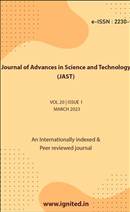Application of Geo-Physical Survey in Structural audit of Dams in Maharashtra
DOI:
https://doi.org/10.29070/njzpn165Keywords:
Geo-Physical Survey, Structural Audit, Dams, Maharashtra, Stability, Integrity, Damage, Operational Capabilities, Risk, Life, Property, Economic Loss, Dam Safety, Planning, Design, Construction, Maintenance, Operation, Distress, Nature of Damage, Inspection, Rehabilitation Measures, Material Properties, Geo-Technical Investigation, Soils, Rocks, Particle Size, Characterization, Reliability, Static Applications, Seismic Applications, Geotechnical EngineeringAbstract
Stability and integrity of any dam structure is always of great concern since any possibledamage in the structure can affect its operational capabilities and may pose risk to the life and propertyat downstream of the dam at the time of failure, besides causing huge economic loss. Dam safety isconsidered an inherent function in the planning, design, construction, maintenance and operation ofdams. In spite of taking due care in planning, design and execution stages many of such dams haveshown signs of distress. It has been recognized worldwide that dam safety aspects, particularly of theexisting dams, are not receiving adequate attention even as the number of oldexisting dams are aging.One of the important aspects of this safety is to assess the nature of likely damage if the proposed damfails. Lessons from the past have taught us the fact that dams with a perfectly safe design some fifty orhundred years ago are not safe anymore with present dam safety standards. Majority of the presentdams therefore need a thorough inspection and subsequent rehabilitation measures, as they have beenconstructed a century back and gradual wearing of material properties inclusive of some structuraldistresses of the dams must have taken place during passage of time.To assess the health of the dam, application of Geo-physical survey method found to be reliable andpowerful tools for Geo-technical Investigation. They cover the whole range of soils and rocks,independently of particle size, and provide data in the natural state for the characterization at differentscales. Assessment of the reliability of the most popular techniques is therefore of primary importancefor static and seismic applications. This is also considered to provide an insight on the consequences inthe practice of geotechnical engineering.Downloads
References
Georgia S. Mitsika, John D. Alexopoulos, Ioannis Konstantinos Giannopoulos, Nicholas Voulgaris, Preliminary results of near-surface geophysical survey in Lefkada town (Greece).
Leonides Guireli Netto, Otavio Coaracy Brasil Gandolfo, Walter Malagutti Filho, João Carlos Dourado, Non-Destructive Investigation on Small Earth Dams using Geophysical Methods: Seismic Surface Wave Multichannel Analysis (MASW) and S-Wave Refraction Seismic Methods.
Yunsen Wang, Neil Anderson, Evgeniy Torgashov, Condition Assessment of Building Foundation in Karst Terrain Using both Electrical Resistivity Tomography and Multi-channel Analysis Surface Wave Techniques.
Abbas Ali,Raafat E. Fat-Helbary, Karrar El-Faragawy, Ahmed Hamed Aswan, The implementation of shallow geophysical survey for detection of some buried archaeological structures in Aswan city, Egypt.
Koya Suto, Milovan Urosevic, Milenko Burazer, Snezana Komatina, An integrated analysis of geophysical data for landslide risk assessment.
Anbazhagan Panjamani, Divyesh Rohit, Athul Prabhakaran,Vidyaranya Bandi, Identification of Karstic Features in Lateritic Soil by an Integrated Geophysical Approach.
Dewan Mohammad Enamul Haque, Asm Woobaidullah, The Effectiveness of Shallow Surface Geophysical Methods in Shear Wave Velocity Derivation.
K. S. Ishola, waezuoke C.C.,Elijah A Ayolabi, Electrical resistivity imaging and multichannel analysis of surface waves for mapping the subsurface of a Wetland Area of Lagos, Nigeria.
Guillermo Zavala, Saulo López, Cindy Ebinger, Rafael Aguilar, Preliminary geophysical survey for assessing the geotechnical conditions and geohazards at Huaca de la Luna, Perú.
George Kritikakis, A Vafidis, Zach G. Agioutantis, D Kanaris, Contribution of the Multichannel Analysis of Surface Waves (MASW) method in the geotechnical characterization of soils.
Tomio Inazaki, Sakamoto Tadahiko, Geotechnical characterization of levee by integrated geophysical surveying.






